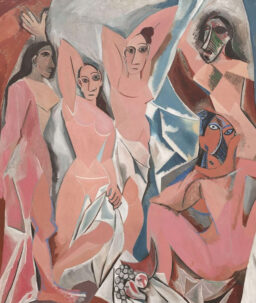Pioneered by Pablo Picasso and Georges Braque in the early 20th century, the art movement Cubism, categorized by its use of geometric shapes and fragmented forms, was revolutionary for artists by challenging artist's views on the world and art. Cubism continues to shape artists beyond a canvas and across other mediums such as fashion and architecture.
Before the early 20th century, European artists had a distinct style of art they would use to create their paintings. They often followed realism which was defined by a focus on perspective, depth, and three-dimensional figures; trying to make their art look as life-like as possible highlighting skill, accuracy, and the ordinary. While it was adopted by many creatives, with the growing popularity of photography as a conventional tool used to capture reality, the need to create realistic paintings began to decrease.
By the early 1900s, artists began approaching their work differently and with a new lens. As several modernism and avant-garde art movements were on the rise, traditional art traditions and perspectives were being challenged and discarded. One of the most influential movements of this time was Cubism. As of today, Cubism remains one of the most revolutionary and relevant art movements to live, and continues to extend its impact outside of a canvas onto other mediums such as sculptures, architecture and even fashion.
Cubism as a movement was led by Spanish artist, Pablo Picasso and French artist, Georges Braque in Paris between 1907 and 1914 with paintings that created the foundational work for Cubism. It was given its name by the French art critic Louis Vauxcelles, after seeing the landscapes Braque had painted in 1908 which resembled cubes. This art movement presented a new perspective of how we see the world around us and break apart the single viewpoint found in famous paintings at the time. It’s characterized by its use of geometric shapes, fragmented and abstracted form, multiple perspectives of the same subject, its focus on flatness, and it is not bound to texture, color and space. These characteristics can be seen in both Picasso’s and Braque’s initial works with Cubism.

Picasso's Les Demoiselles d’Avignon, 1907 depicted five nude women whose bodies were distorted, angular, with faces inspired by African and Iberian tribal masks.

Elsa Schiaparelli Lobster Dress (1937)
Cubism’s revolutionary approach to representing reality left a long lasting impact, influencing other artists, from sculptures to fashion and the way designers crafted beyond the canvas. Fashion designers started to move away from traditional silhouettes and color palettes and began experimenting with different structures, colors, angles, and incorporating bold geometric shapes and patterns. 20th- century French artist and designer, Sonia Delaunay, used cubist principles to carry out her designs incorporating abstract shapes and silhouettes in her 1913 Robe Simultanee. The concept of this dress was the most important piece in Delaunay’s career and influenced the fashion at that time.
Another example is Italian fashion designer Elsa Schiaparelli and her most iconic piece, Lobster Dress (1937). This dress features a bold, surrealist lobster theme on a silk dress. This piece was considered bold, unconventional and unexpected during its time, aspects found in Cubism. This piece shifted away from traditional fashion and introduced more designs that challenged common aesthetics.
Cubism continues challenging artists to approach their art differently and to not be afraid to reject current traditional norms. Its lasting impact over centuries teaches creatives to take an unconventional approach. Emerging at a time when photography was being revolutionized, Cubism proved that artists can be used to reinterpret the world around them without the use of cameras, pushing boundaries, and forever holding its place as one of the most transformative art movements in history.
